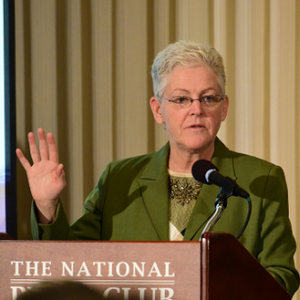Almost every EPA Administrator since the creation of the agency has talked glowingly about the need to maintain a strong economy while protecting the environment. Yet this agency in recent years has been broadly and consistently criticized for its unwillingness to take into account the economic toll that its agenda has taken over the years and is poised to take in the future as new regulations – such as tightened ozone standards – are pursued.
But in remarks delivered at the annual CERAWeek conference, Administrator Gina McCarthy doubled down on her rejection of the widespread economic concerns associated with the administration’s regulatory agenda, papering over fears about job loss and restricted growth with the bold but well-worn assertion that tighter air regulations will in fact make our economy stronger.
While EPA Administrator McCarthy can be praised for her messaging diligence, you’ll forgive manufacturers and countless other businesses, consumers, and families across the nation for taking little comfort in her claims.
The simple fact of the matter is that regardless of the EPA’s cheerful and optimistic talking points, the reality of the agenda in action is defined by gross underestimations of the economic cost of EPA regulations, drastic impact on our nation’s economic prospects, and – too often – a profound lack of clarity when it comes to the manner in which the regulations pursued can even be implemented.
With the Agency on the verge of finalizing a new ozone standard that, if implemented, would be the most-costly regulation in our nation’s history, EPA Administrator McCarthy’s rhetoric must be looked at with even greater scrutiny. That rhetoric simply doesn’t match the reality – and recent history provides ample evidence of that fact.
For instance, when EPA forecasted the cost of its power plant mercury rule, it concluded that only 4.7 gigawatts of coal-fired power would be forced to retire. EPA was off by a factor of ten, as nearly 50 gigawatts are slated to retire because of EPA power plant regulations. These disruptions mean lost jobs and lower energy reliability for manufacturers.
Similarly, a recent tailpipe emissions regulation for construction equipment requires levels so strict, on a timeline so aggressive, that one small manufacturer reports having to spend 90 percent of its research and development (R&D) budget simply to comply with the regulation. This is money manufacturers should be spending on new products to compete in the global marketplace. It’s money that, if invested in a more productive manner, could help to power our ongoing manufacturing comeback, creating American jobs and keeping our economic recovery on track.
These are far from isolated events, but indicative of a trend. When EPA first issued its Boiler MACT regulation, the standards that they proposed were so unrealistic that not a single boiler could meet all of the rule’s requirements. In 2012 and again in 2014, the EPA’s proposed New Source Performance Standards (NSPS) for new coal-fired utilities at levels that were neither being achieved in practice nor which could be achieved by any commercially available technology.
Next on the list? A revision of ground-level ozone standards that, as we’ve consistently maintained, is poised to become the most costly regulation ever imposed on our economy, draining $140 billion per year from the nations GDP. But beyond the economic impact are familiar concerns about the achievability and practicality of the standards that EPA is set to pursue. In its own data, for instance, EPA is only able to identify about 65 percent of the emissions reduction controls and technologies needed to meet their target. The rest is simply left to the unknown – literally – in the form of “unknown controls” that the EPA simply hopes that business and industry will be able to develop in time to comply.
All of this in pursuit of a new standard that, by the Administrator’s own admission, may not even be necessary given the fact that existing efforts to reduce air pollutants are on track to put almost all of our nation (all but nine counties) at or below 70 parts per billion by 2025.
Manufacturers have often been nimble enough to innovate our way out of regulatory problems, reducing emissions steadily while still investing, expanding, and growing in a manner that has helped our economy to recover from the recent recession.
But the EPA’s lowball economic forecasts, unfeasible targets, and quixotic visions of economic benefit have been increasingly off base, and that is costing manufacturers – and our economy at large – dearly.

